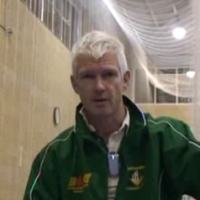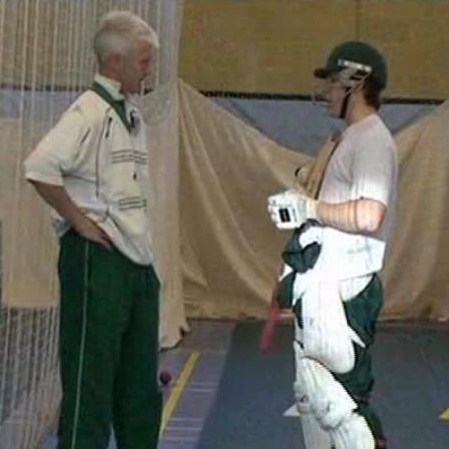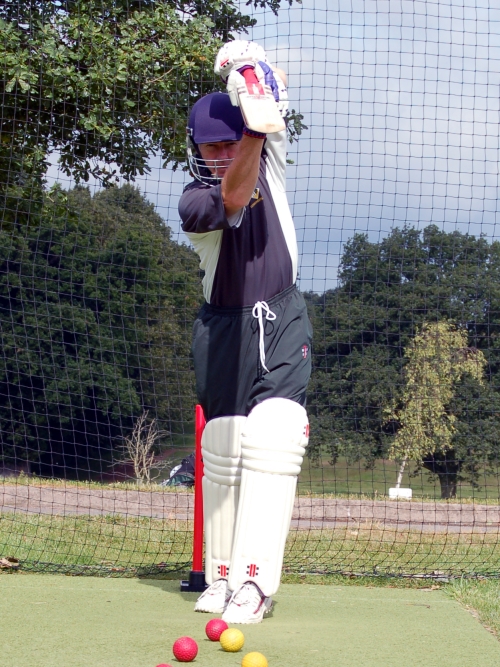7 Stages of Improving Batting Technique
 Gary Palmer is a batting coach and former-first class cricketer. You can find out more about Gary's coaching guides here. In this article he talks about the process of developing batting technique. Essential reading for all coaches.
Gary Palmer is a batting coach and former-first class cricketer. You can find out more about Gary's coaching guides here. In this article he talks about the process of developing batting technique. Essential reading for all coaches.
Technique is the key.
Correcting batting technique is still the best way to improve your batting. An excellent technique gives you the tools you need to score huge numbers of runs in the summer. The best coaches teach the basics to the highest levels as they are the foundations of long term development.
I have coached many batsmen - from club to International level - and I have developed a method that guides a player to the right place and, eventually, allows him or her to self-coach. That said, coaches have a wealth of experience so don't expect players to initially lead their own technical coaching and skill development. The coaches role is vital.
So, if the ball has not come out of the middle of the bat and gone to the correct target area, here is that process in full.
1. Identify the fault at its source
I feel we must learn what perfection looks like so that we have a reference point to easily spot imperfections. Only then can we rapidly improve a players technique. Coaches who don't work from perfection will be going round in circles playing a guessing game on what to do. The player will get confused because they will waste lots of time with "trial and error".
However, this first step is the most difficult. It's easy to step in when you see a fault, but on further analysis you see that the error is further back along the chain. A fault with the drive may start in the set up. It's something I talk about in the video in Chapter 3 of my course on grip, stance and backlift.
So, get the player to repeat the shot a few times. Watch technique for a few minutes. With practice, the time you take will reduce, but don't be afraid to watch, analyse and say nothing. Take as long as you need in assessing. Work to perfection.
Form your plan of action in your head about the adjustments you need to make. Try to identify source of faults first time. Something that helps me in this process is thinking about each stage of a shot:
- Set up
- Leaning in to step forward/backward
- Contact with ball
- Completion of shot/follow through
Think about the player's Alignment, Balance and Completion (ABC) at each stage and compare it to the perfect model.
The check list for the basics is the same for everybody. Some players get closer to perfection than others but we should all be going in the same direction.
When you are ready, move to the next stage.
2. Explain fault to player
The first step towards correction is to define the problem to your player.
Most of the time a player will not know there is a technical fault, so explain briefly the issue. If you have video access you can also show the error, but I prefer to move on to the next stage after a quick summary.
Your interaction with and understanding of the player here is crucial. Some players quickly accept what you say and want a solution they can visualise. Others will prefer to discuss the issue in more detail and question your views. Learning to handle different responses helps your coaching a great deal.
3. Explain correction
You should already know the change you wish to make. Explain this to the player clearly. Making a technical change is like going on a trip: You need to know the destination if you want to get there.

4. Explain the benefits of correction
Some players need more detail than others at this point. If you want a player's weight to be more central and balanced explain why this is important and what will go wrong if it is not corrected.
Again, some players will question and challenge more than others. This is not a bad thing either way, but you need to be confident the player trusts your solution before moving on. Don't let players just do what is comfortable because "comfortable" may not have the most effective outcome. Don't let players do what they think is right if you know in the long term it will restrict them as a player.
5. Visually show correction
You have to have a technically excellent demonstration. Most people respond better to seeing a correction than hearing it.
6. Identify specific drill and groove
You then practice the change that you have discussed using a drill. Grooving is crucial as you can't correct technique in nets with bowlers. Don't try a drill unless you know what you are correcting.
Here are some drills to use to correct specific issue.
7. Prescribe drills to service and challenge correction
Keep it simple. There are not lots of different ways of executing the basic straight batted shots, there is a common effective and efficient way where the technical coaching point should all be the same. Some players will achieve those points and some will get close to them, but a least there are no mixed messages.

If your player has been doing something incorrectly for a while it will feel comfortable but the outcome may be ineffective. When you make changes to improve the outcome it can feel uncomfortable for a while. This does not mean its the wrong technique.
It's very dangerous to say to a young player "do what's comfortable" because that could be the incorrect technique. As long as the player keeps doing what's comfortable they are slowing down the process of developing their skill level and performance.
When a player hits what you see as a technically correct shot, let them know that they have achieved perfection so that they know exactly what it feels like and therefore will find it easier to reproduce.
Remember to complement the player when they get a particular part of technique right that you have been working on even if other things are still not corrected yet. Complement the achievement while making it known to them that other things are still in need of attention. The better the player the more you should expect perfection the lesser players need a bit more time and space to get thing right.
It's important to progress or regress the drills to challenge the player. If a player finds a drill easy, you make it harder to further challenge technique. If the player can't do the drill, simplify until they master the technique.
Players need guiding with a coaches' technical expertise through this process.
What next?
Once the player starts understanding their technique, the coach can start asking the player what he or she thinks because the correct information is already in the players head.
You need to get the balance: First feed the information in and then question the player to get it out so the player begins to self coach. Show a player what perfection looks like and get them to keep finding it until they can do it them selves.
The correct technical information must be relayed to the player in the first place before you start the questioning, especially where the basics of technique are concerned.
To help you with this process I have developed a reference sheet for coaches dealing with batting technique. You can download the pdf by clicking here.
- Login to post comments


Comments
i want to improve my batting so, i need a coach but i cant afford that so i wanna be a learner of sir gary.i need their guidelines.he is really a great coach.